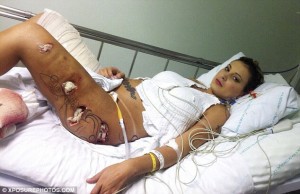Miss Urach came second in the 2012 Miss Bumbum competition, which scours Brazil for the most attractive behind in the land.
Ahead of the competition, Miss Urach, who hit headlines around the world after claiming she had had an affair with footballer Cristiano Ronaldo, a claim he strenuously denied, had injected two types of ‘body fillers’, hydrogel and PMMA, into the u pper legs to fill out the thighs and lift her bottom.
pper legs to fill out the thighs and lift her bottom.
In July this year the model discovered that the products were causing her leg muscles to rot, leaving her in excruciating pain.
In an interview with Brazil’s R7 website, she said: ‘The hydrogel was not absorbed by my body and started to harm me. Now I’ve discovered that the PMMA is sticking to my muscles and causing the tissue to rot.
‘That’s why I am feeling such strong pains. I’m taking morphine every four hours and antibiotics to alleviate the suffering.’
 Andressa Urach went from being a single teenage mom nicknamed “Beanpole” to a reality TV bombshell in Brazil thanks to silicone implants, anabolic steroids, a nose job, and gel and botox injections, a fact she wasn’t ashamed to share with fans.
Andressa Urach went from being a single teenage mom nicknamed “Beanpole” to a reality TV bombshell in Brazil thanks to silicone implants, anabolic steroids, a nose job, and gel and botox injections, a fact she wasn’t ashamed to share with fans.
“There are plenty of ugly women,” she said last year. “If you have the money, you can be beautiful. This pretty face you see here, my dear, it costs some.”
More, it turns out, than she bargained for.
The 27-year-old Urach, arguably Brazil’s most outspoken advocate of advancement through cosmetic surgery, recently went into septic shock and was placed on life support after a botched operation to augment her thighs, sparking a debate about the risks Brazilian women will take for beauty at a moment when the nation has surpassed the U.S. as the world’s plastic surgery capital.
It led the runner-up in Brazil’s “Miss Bum Bum” contest, who is still trying to fully recover, to express regret at her decision to flaunt her surgically enhanced flesh for fame and money.
“We lose our health to get rich,” she recently posted on her Instagram account. “We live as if we are never going to die.”
Since Urach’s ordeal, several celebrities have come forward to disclose that similar procedures had sent them to the hospital. In October, a 39-year-old woman died from a pulmonary embolism hours after hydrogel was injected in her buttocks in the city of Goiana.
Experts and activists worry that Brazil’s culture of beauty has numbed women to the dangers and encouraged them to experiment with riskier, untested materials and methods and even unlicensed practitioners.
“They are selling us these plastic surgeries, these synthetic injections like it was any other product,” said Sara Winter, a women’s rights activist who protested on Copacabana beach in December with a large needle made of cardboard and signs sending good wishes for Urach’s recovery.
While Brazil has around 5,500 certified plastic surgeons, another 12,000 doctors without specialized training are performing cosmetic procedures, according to the countr y’s Federal Council of Medicine, which is in charge of medical licenses. And some women turn to paramedics, or even people with no medical training at all.
y’s Federal Council of Medicine, which is in charge of medical licenses. And some women turn to paramedics, or even people with no medical training at all.
Brazil’s Plastic Surgery Society said Urach was given a dose of silicone gel 200 times what the government allows and used a hydrogel that isn’t approved by the U.S. Food and Drug Administration. It’s not clear where or even who carried out the procedure on Urach; she hasn’t disclosed the information.
Despite the debate there is no sign of flagging demand to fight sagging flesh.
Brazil recently surpassed the United States in plastic surgeries, with 1.5 million procedures in 2013, according to the International Society of Aesthetic Plastic Surgery.
One of Urach’s closest friends, Jessica Lopes, a reality TV star she met in the Miss BumBum contest, told the celebrity news site EGO that the two used to schedule visits to the plastic surgeon together as if it were “a trip to the mall.”
Many young women visit doctors asking to look like models such as Urach, or at least to improve their self-esteem.
Brazil’s Dr. Ivo Pitanguy, one of the world’s top plastic surgeons, has urged doctors to think of themselves as “a psychologist with a scalpel in his hand.”
“Women’s lives changed,” said Dr. Fernando de Almeida, president of the Sao Paulo chapter of the Society of Plastic Surgery. “Plastic surgery helps women who thought their life was over just because their breasts sagged and their belly got ugly.”
“Plastic surgery is so tied to this dream of becoming somebody,” said Alvaro Jarrin, a College of the Holy Cross professor who has researched the expansion of plastic surgery among low-income patients in Brazil. “For the growing middle class with more purchasing power, plastic surgery is a means for upward mobility.”
Urach once said that she had her nose job “to have the face of a rich girl,” and after placing runner-up in the a 2012 beauty pageant that crowned Brazil’s best bottom, Urach was invited to a reality show where she stripped naked and became a TV host known for incidents like pouring water on her breasts while interviewing politicians about a drought hitting southeast Brazil.
For Vania Prisco, a 31-year-old Rio de Janeiro lawyer, Urach’s problems were a reminder of her own botched operation.
Prisco is still recovering from a 2013 surgery carried out by a woman she later discovered didn’t have a medical degree. The procedure was to put a type of acrylic glass filler in her bottom to add more shape, but it resulted in an infection that spread throughout her body and left her hospitalized for six months. Prisco filed a police report, but authorities have yet to locate the woman who carried out the procedure.
“I was misled. I only heard the good things. No one tells you about all the problems it will cause you,” said Prisco. “I did something stupid. I didn’t even need this because I looked good. In the end I forgot that the most important thing is to be healthy and happy.”














